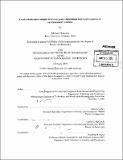| dc.contributor.advisor | Anne L. Cohen and Daniel C. McCorkle. | en_US |
| dc.contributor.author | Holcomb, Michael (Michael C.) | en_US |
| dc.contributor.other | Woods Hole Oceanographic Institution. | en_US |
| dc.date.accessioned | 2010-09-02T15:00:15Z | |
| dc.date.available | 2010-09-02T15:00:15Z | |
| dc.date.copyright | 2010 | en_US |
| dc.date.issued | 2010 | en_US |
| dc.identifier.uri | http://hdl.handle.net/1721.1/58196 | |
| dc.description | Thesis (Ph.D.)--Joint Program in Oceanography/Applied Ocean Science and Engineering (Massachusetts Institute of Technology, Dept. of Earth, Atmospheric, and Planetary Sciences; and the Woods Hole Oceanographic Institution), 2010. | en_US |
| dc.description | Cataloged from PDF version of thesis. | en_US |
| dc.description | Includes bibliographical references. | en_US |
| dc.description.abstract | The mechanisms involved in the formation of coral skeletons are examined using a laboratory model for coral calcification and the growth of living corals under different environmental conditions. Abiogenic aragonite was precipitated from seawater over a range of saturation states (Chapter 1). Abiogenic aragonite formed at high saturation state ([Omega]>~20) had a granular appearance and was enriched in trace elements, similar to the crystals found within the centers of calcification and dark bands in coral skeletons. Abiogenic aragonite formed fibrous crystals at lower saturation states, similar to the crystals which radiate out from the centers of calcification. These similarities suggest that the internal calcifying environment of the coral experiences a wide range of saturation states. To estimate when periods of high or low saturation state occur within the coral, corals were stained to mark the skeleton deposited during specific time intervals (Chapter 2). Dark bands are shown to form between dusk and dawn. A conceptual model is proposed in which daytime saturation state is limited by the availability of CO₂ due to the uptake of CO₂ by photosynthesis. To test the potential for photosynthesis to limit CO₂ availability to calcification, corals were grown under experimentally manipulated CO₂ and nutrient levels. Elevated CO₂ levels were found to decrease calcification in zooxanthellate colonies of the coral Astrangia poculata, however the addition of inorganic nutrients reduced the negative impact of CO₂ (Chapter 3), while reduced calcification rates were associated with elevated nutrients at ambient CO₂ levels. Together these results suggest that nutrient availability may limit photosynthesis under elevated pCO₂ conditions, while at ambient conditions additional stimulation of photosynthesis may limit the CO₂ supply to calcification. To further test the interaction of photosynthesis with calcification, the effects of nutrients, CO₂, and temperature were tested on both zooxanthellate and azooxanthellate coral colonies (Chapter 4). No clear pattern of nutrient enhancement of photosynthesis or calcification was found. However, a pronounced gender difference was found in the effect of CO₂ on calcification in spawning corals, with female corals being more sensitive to elevated CO₂. | en_US |
| dc.description.abstract | (cont.) Coral calcification is examined using a laboratory model and living corals. In the laboratory model, abiogenic aragonite formed at high saturation state ([Omega]>~20) had a granular appearance and was enriched in trace elements, similar to centers of calcification and dark bands in corals. Abiogenic aragonite formed fibrous crystals at lower saturation states, similar to crystals which radiate out from centers of calcification. These similarities suggest the calcifying environment of the coral experiences a range of saturation states. To estimate when high or low saturation states occur within the coral, living corals were stained, staining patterns suggest dark bands form between dusk and dawn. A model is proposed in which daytime saturation state is limited by the availability of CO₂. To test the potential for photosynthesis to limit CO₂ availability to calcification, corals were grown under altered CO₂ and nutrient levels. Elevated CO₂ levels decreased calcification in zooxanthellate corals, however addition of nutrients reduced the negative impact of CO₂. This suggests nutrient availability may limit photosynthesis under elevated pCO₂2 conditions. The effects of nutrients, CO₂, and temperature were further tested on both zooxanthellate and azooxanthellate coral colonies. Unexpectedly, a gender difference was found in the effect of CO₂ on calcification. | en_US |
| dc.description.statementofresponsibility | by Michael Holcomb. | en_US |
| dc.format.extent | 274 p. | en_US |
| dc.language.iso | eng | en_US |
| dc.publisher | Massachusetts Institute of Technology | en_US |
| dc.rights | M.I.T. theses are protected by
copyright. They may be viewed from this source for any purpose, but
reproduction or distribution in any format is prohibited without written
permission. See provided URL for inquiries about permission. | en_US |
| dc.rights.uri | http://dspace.mit.edu/handle/1721.1/7582 | en_US |
| dc.subject | Joint Program in Oceanography/Applied Ocean Science and Engineering. | en_US |
| dc.subject | Earth, Atmospheric, and Planetary Sciences. | en_US |
| dc.subject | Woods Hole Oceanographic Institution. | en_US |
| dc.subject.lcsh | Calcification | en_US |
| dc.subject.lcsh | Carbon dioxide | en_US |
| dc.title | Coral calcification : insights from inorganic experiments and coral responses to environmental variables | en_US |
| dc.type | Thesis | en_US |
| dc.description.degree | Ph.D. | en_US |
| dc.contributor.department | Joint Program in Oceanography/Applied Ocean Science and Engineering | en_US |
| dc.contributor.department | Woods Hole Oceanographic Institution | en_US |
| dc.contributor.department | Massachusetts Institute of Technology. Department of Earth, Atmospheric, and Planetary Sciences | |
| dc.identifier.oclc | 651645342 | en_US |
